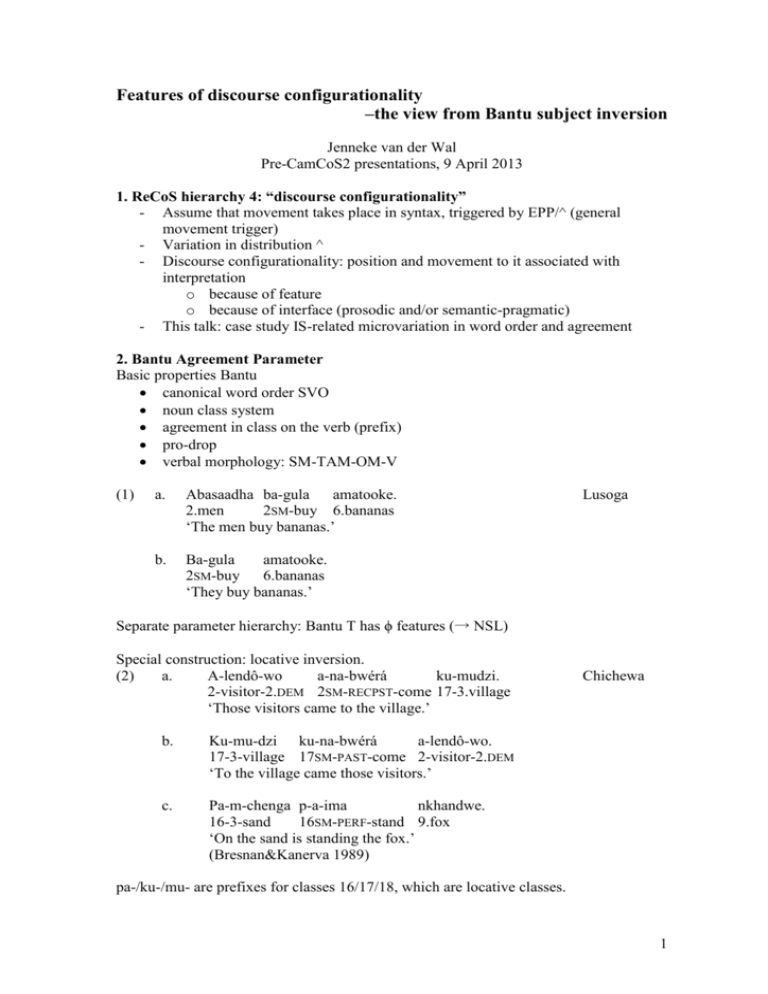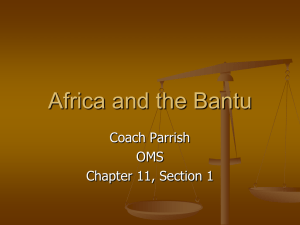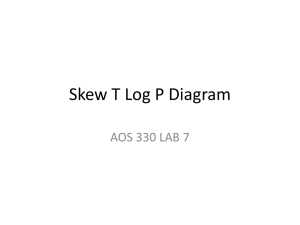handout CamCoS 2 - Rethinking Comparative Syntax
advertisement

Features of discourse configurationality –the view from Bantu subject inversion Jenneke van der Wal Pre-CamCoS2 presentations, 9 April 2013 1. ReCoS hierarchy 4: “discourse configurationality” - Assume that movement takes place in syntax, triggered by EPP/^ (general movement trigger) - Variation in distribution ^ - Discourse configurationality: position and movement to it associated with interpretation o because of feature o because of interface (prosodic and/or semantic-pragmatic) - This talk: case study IS-related microvariation in word order and agreement 2. Bantu Agreement Parameter Basic properties Bantu canonical word order SVO noun class system agreement in class on the verb (prefix) pro-drop verbal morphology: SM-TAM-OM-V (1) a. Abasaadha ba-gula amatooke. 2.men 2SM-buy 6.bananas ‘The men buy bananas.’ b. Ba-gula amatooke. 2SM-buy 6.bananas ‘They buy bananas.’ Lusoga Separate parameter hierarchy: Bantu T has ϕ features (→ NSL) Special construction: locative inversion. (2) a. A-lendô-wo a-na-bwérá ku-mudzi. 2-visitor-2.DEM 2SM-RECPST-come 17-3.village ‘Those visitors came to the village.’ b. Ku-mu-dzi ku-na-bwérá a-lendô-wo. 17-3-village 17SM-PAST-come 2-visitor-2.DEM ‘To the village came those visitors.’ c. Pa-m-chenga p-a-ima nkhandwe. 16-3-sand 16SM-PERF-stand 9.fox ‘On the sand is standing the fox.’ (Bresnan&Kanerva 1989) Chichewa pa-/ku-/mu- are prefixes for classes 16/17/18, which are locative classes. 1 As it seems that the subject marker agrees with the preverbal element, Collins (2004), Carstens (2005) and Baker (2003, 2008) postulate that agreement and movement are tied together in Bantu languages. In more formal terms, Collins and Carstens1 say that the head responsible for subject agreement not only has uninterpretable ϕ features which probe for any suitable goal, but it also has a movement trigger (EPP feature) which is responsible for moving the agreed-with goal to the specifier of that head. Collins (2004: 116) proposes the Agreement parameter for Bantu languages: (3) Agreement Parameter (minimally adapted): Let Agree (X, YP), where X contains the probe (uninterpretable phi-features) and YP contains the goal, then X has an EPP feature that is satisfied by YP However, if we look in detail, we find a wealth of variation in subject inversion constructions,2 with differences in word order, transitivity and subject agreement: Subject-Object Reversal (4) a. Yohani a-á-ra-somye ibitabo 1.John 1SM-PST-DJ-read:PERF 8.books ‘John has read books’ b. Ibitabo bi-á-somye Yohani. 8.books 8.SM-PST-read:PERF 1.John ‘John (not Peter) has read (the) books.’ (lit. ‘The books read John.’) (Ndayiragije 1999:418) Instrument Inversion (5) a. U-John u-dla nge-sipunu. 1a-1a.John 1aSM-eat with-7.spoon 'John is eating with the spoon.' b. Kirundi Zulu I-sipunu si-dla u-John. 7-7.spoon 7SM-eat 1a-1a.John 'John is using the spoon to eat.' (lit. 'The spoon is eating John.') (Zeller 2011) Default Agreement Inversion (6) Hó-tswalá lipó:li. 17SM-give.birth 10.goats ‘There are goats giving birth.’ (Demuth 1990:239) Sesotho 1 Baker (2008) proposes a different analysis in which languages are parameterised as to whether agreement is ‘downward’ (with a c-commanded element) or ‘upward’ (with an element c-commanding the agreeing head), where Bantu languages in general have an ‘upward’ setting. In terms of variation in features, this comes down to saying that subject agreement is always associated with a movement trigger, unless one assumes delayed valuation (Henderson 2011). 2 An afterthought/ right-dislocated subject construction (‘he arrived, the man’) exists in all Bantu languages independently of VS constructions. That is not the focus of this research. 2 Agreeing Inversion (7) U-hin-iki u-nyagu wôla. 14SM-dance-STAT.ANT 14-ceremony 14.DEM3 ‘The ceremony was danced.’ (Heidrun Kröger, p.c.) Mozambican Ngoni All subject inversion constructions have in common that the logical subject is in a postverbal position and that the subject is not topical (may be a thetic sentence or subject focus). In general, focal elements are banned from the preverbal domain in Bantu languages. However, not everything is possible: agree pre-V XP agree post-V XP agree S (1) (7) agree non-S (2b,c)(4)(5) → What allows a non-subject to be in an agreement relation with T is dependent on movement to the preverbal position, i.e. dependent on the movement trigger. 3. Distribution movement trigger NB: The languages mentioned and illustrated in this section represent a type of language with respect to inversion constructions; see the appendix for which languages (may) group together. → ReCoS: dependent parameters. The first question, after establishing that T has ϕ, should therefore be: Does T[ϕ] always have ^? If the answer is ‘no’, then a next question can be: N Does T[ϕ] always have ^? 3 Does T[ϕ] sometimes have ^? N mafia! Y Matengo Y Matengo thus has T with and without a movement trigger. This ‘optionality’ deriving SV and VS order should result in a difference in interpretation, according to Reinhart’s (1995, 2006) interface economy. Indeed: pre-V interpreted as topical, post-V as nontopical. Not having ^ on T ever is probably a “mafia” option (an offer you cannot refuse), because the PLD tells you very clearly that the subject can end up pre-V. 3 3 (8) T[ϕ,^] Matengo a. Ńkongu gu-hábwǐ:ke. 3.tree 3SM-fall.PERF (As a comment on a particular tree) ‘The tree has fallen down.’ T[ϕ] b. Gu-hábwiki ńko:ngo. 3SM-fall.PERF 3.tree (As a thetic sentence)‘A tree has fallen down.’ (Answer for “What has fallen down?”)‘A tree has fallen down.’ (Yoneda 2011:756) (9) Páámbá ngase ju-á-bwiki múundo. here NEG 1SM-PAST-fall.PERF 1.person ‘Nobody has fallen down here.’ (elicitation) Locative (10) a. Máhimba ga-a-tam-iti 6.lions 6SM-PAST-live-PF ‘Lions lived in the forest.’ mu-kítengu. 18-7.forest b. *Mu-kítengu mu-a-tam-iti 18-7.forest 18SM-PAST-live-PF Intended: ‘In the forest lions lived.’ máhimba. 6.lions c. Mu-kítengu ga-a-tam-iti máhimba. 18-7.forest 6SM-PAST-live-PF 6.lions ‘In the forest lions lived.’ (Yoneda 2011:770) 4. Distribution discourse feature If T[ϕ] always has a movement trigger, we get to the dependent parameter on discourse features. Assuming a non-specific discourse-feature δ for now (think of it as a topic feature4), the next question is:5 Makhuwa N N Does T[ϕ,^] always have δ? Does T[ϕ,^] sometimes have δ? Y Y 4 Many scholars have observed “that postverbal or VP-internal material in Bantu languages receives a new information or focus interpretation (Givon 1972, Bokamba 1976, 1979, Bresnan and Mchombo 1987, Machobane 1995, Demuth and Mmusi 1997). On the other hand, preverbal elements such as subjects tend to be interpreted as old information and function as topics.” (Henderson 2006:288) 5 This can perhaps alternatively be phrased in Miyagawa’s (2010) terms as whether T inherits a [-foc] feature from C. 4 If T has and ^ but no further specifications, it will agree with the closest goal (assuming relativised minimality), which is the subject, and move it up. This I argue to be the case in Makhuwa, and Diercks (2011) argues the same for one construction in Lubukusu.6 Agreement is with the subject, whether pre- or post-verbal, and VS order is derived by “optional” movement of the verb over the subject (Van der Wal 2009 and 2012). This movement ‘detopicalises’ the subject, thereby satisfying interface economy. (11) Ni-hoó-wá n-láikha. 5SM-PERF.DJ-come 5-angel ‘There came an angel.’ (12) 2 Makhuwa AgrSP 2 ho- TAM 2 ∅ AspP 2 2 -tswalai (13) 2 vP 5 lipoli ti FinSP nlaikhaj AAgrSP 2 2 ni- TAM 2 -hooAspP 2 2 -wai (14) a. vP 5 tj ti Wakisírwá a-náá-phíyá alétto. 16.island 2-PRES.DJ-arrive 2.guests ‘On the island arrive guests.’ 6 Diercks (2011) does not assume Julien’s (2002) structure for verb movement (like I do for Makhuwa) and hence has a different derivation of the agreeing VS construction in Bukusu, where the locative is in spec-CP, the subject in spec-TP and the verb moved to C. 5 b. * Wakisírwá wa-náá-phíyá alétto. 16.island 16-PRES.DJ-arrive 2.guests If δ is only sometimes associated with T, then we expect both Agreeing Inversion (as in Makhuwa) and Locative Inversion when δ is associated with a locative XP. This is the system of Bukusu. (15) a. Kú-mú-saala kw-á-kwá mu-mu-siiru. 3-3-tree 3SM-PST-fall 18-3-forest ‘A tree fell in the forest.’ Lubukusu Agreeing inversion b. Mú-mú-siirú kw-á-kwá-mó kú-mú-saala. 18-3-forest 3SM-PST-fall-18l 3-3-tree ‘In the forest fell a tree.’ Locative Inversion c. Mú-mú-siirú mw-á-kwá-mó kú-mú-saala. 18-3-forest 18SM-PST-fall-18l 3-3-tree ‘In the forest fell a tree.’ (Diercks 2011) Makhuwa N N Does T[ϕ,^] sometimes have δ? Does T[ϕ,^] always have δ? Y Bukusu Y ? 5. Association with discourse feature The systems that have the setting T[ϕ,^,δ] never have (indifferent) agreement with the postverbal subject.7 These are distinguished with respect to which category δ can attach to (we can think of it in terms of subcategorisation of δ). Sotho N N Does δ occur on the next subclass? Does δ occur on any XP? Y Y Zulu Herero Kirundi 7 For arguments showing that the preverbal agreeing locative, object or instrument DP are in spec-TP (or at least an A position), see tests in Ndayiragije (1999), Morimoto (2000), Buell (2005, 2007), Zeller (2011). 6 7 → δ associates with any XP/DP: Kirundi, Kinyarwanda Theme (16) Ibitabo bi-á-somye Yohani. 8.books 8SM-PST-read:PERF 1.John ‘John (not Peter) has read (the) books.’ (Ndayiragije 1999:418) Kirundi Instrument (17) Ikaramu y-andikisha John. 9.pen 9SM-write 1.John ‘It is John who writes with a pen’ (Ferdinand Mberamihigo, p.c. March 2013) “Expletive” (18) Ha-á-nyôye amatá abâna. 16-PAST.CJ-drink.PERF 6.milk 2.children ‘Children (not parents) drank milk.’ (Ndayiragije 1999:400) Reason (19) a. b. Baudoin a-rongoye 1.Baudouin 1SM-married ‘B married for wealth’ ubutunzi. 14.wealth Ubutunzi bu-rongoye Baudoin. 14.wealth 14SM-married 1.Baudouin ‘It is B who married for wealth.’ (Ferdinand Mberamihigo, p.c. March 2013) Infinitive (20) Gukina gu-kuunda abaana. 15.play 15SM-like 2.children ‘It is the children who like to play.’ (Morimoto 2000:183) Kinyarwanda Complement clause (21) [Ko abaana b-a-gii-ye] by-iibagiw-e umugore. COMP 2.children 2SM-PAST-leave-PERF 8SM-forget-PERF woman ‘It is the woman (not the man) who forgot that children have left.’ (Morimoto 2000:184) → δ only associates with a subclass (agentive, locative, instrumental DPs / noncomplements): Zulu, Herero Locative (22) Lesi sikole si-fund-ela izingane ezikhubazekile. 7.this 7.school 7-study-APPL 10.children 10.handicapped ‘Handicapped children study at this school.’ (Buell 2007) Zulu 8 Instrument (23) a. U-John u-dla nge-sipunu. 1a-1a.John 1aSM-eat with-7.spoon 'John is eating with the spoon.' b. I-sipunu si-dla u-John. 7-7.spoon 7SM-eat 1a-1a.John 'John is using the spoon to eat.' (Lit. 'The spoon is eating John.') (Zeller 2011) “Expletive” (24) Ku- cula a- bafana. 17SM-sing DET- 2.boys a. ‘The BOYS are singing.’ b. ‘There are boys singing.’ (Buell 2006:13) Agreeing Inversion (25) * Ba- cula a- bafana. 2SM-sing DET- 2.boys (Buell 2006:13) Theme (26) * Inyama i-dla u-John. 9.meat 9SM-eat 1-John int: ‘JOHN eats the meat.’ (Zeller 2011) Difference between Herero and Zulu: locative is DP or PP. Zulu has undergone the Great Locative Shift (Marten 2007); Herero not. → This is an independent parameter! pa/ku/mu-(NPx-)NP Swati (like Zulu): locative prefix = preposition - concord not with locative class but with inherent clas (27) ba-fana ba-mi 2-boys 2-my ‘my boys’ (28) Swati ku-ba-fana ba-mi / *ku-mi LOC-2-boys 2-my ‘at my boys’ (Marten 2010:257) - locative prefix outside of demonstrative, like other prepositions, e.g. ‘nga’ (29) nga-le-moto with-DEM-9.car ‘with this car’ 9 (30) ku-le-si-kolwa 17-DEM-7-school ‘at the school’ (Marten 2010: 258) - object marking not possible for locative (31) *Ngi-ku-bon-e (e-Thekw-ini). SM1SG-OM17-see-PAST LOC-Durban-LOC Intended: ‘I saw it/there (Durban).’ (Marten 2010:261) - resumption possible in Default Agreement, not Locative Inversion (32) a. Lezi zindlu zi-hlala ( *zona / *khona) abantu abakhubazekile. 10.these 10.houses 17-stay 10PRON/there 2.people 2.handicapped ‘These houses are lived in by handicapped people.’ b. Ku-lezi zindlu ku-hlala (khona) abantu abakhubazekile. LOC-10.these 10.houses 17-stay there 2.people 2.handicapped ‘In these houses live handicapped people.’ Zulu (Buell 2007:116) Herero: locative prefix = D - object marking possible for locative (33) ú-pé-térék-èrà ònyámà SM2-OM16-cook-APPL meat ‘S/he cooks meat there’ (Marten et al 2007:308) Locative (34) a. b. Herero Òvà-ndù v-á-hìtí mó-ngándá. 2-people 2SM-PAST-enter 18-9.house ‘The guests entered the house/home’ Mò-ngàndá mw-á-hìtí òvá-ndù. 18-9.house 18-PAST-enter 2-people ‘Into the house entered (the) people.’ (Marten 2006:119) “Expletive” (30) Pé-rísà òvá-éndá òzò-ngòmbé. 16SM.HAB-feed 2-guests 10-cows ‘There feed guests cattle.’ (Marten 2006: 115) 10 → δ only associates with a further subclass (agents / spec-vP): Sotho “Agreeing Inversion” = right dislocation (35) Ó-a-só:ma mo:-nna. 1SM-PRES.DJ-work 1-man ‘He is working, the man.’ (Zerbian 2006a:127) Northern Sotho Locative (36) Mo-tse-ng go tla ba-eti. 3-village-LOC 17SM come 2-visitors ‘To the village come visitors.’ (Zerbian 2006b:368) “Expletive” (37) Go fihla monna. 17SM arrive 1.man ‘There arrives a man.’ (Zerbian 2006a:171) Theme (38) *Puku e bala mo-etsana. 9.book 9SM read 1-girl int ‘A girl is reading the book.’ (Zerbian 2006:365) How does Default Agreement Inversion work? DAI expected to appear if no other (topical, δ) XP is present, so nothing to agree with or move, and a default agreement morpheme is inserted. - VSX can indeed be a thetic sentence where everything is non-topical (which fits the prediction), but VSO is said to have narrow focus on S (Yoneda 2011, Carstens 2012) - How does T’s ^ get satisfied? Alternatively, the availability of DAI can be due to the presence of a null expletive (in the language, and in the numeration of only inverted derivations). - Requires a ‘null expletive parameter’ in addition to distinguishing which phrases can be agreed with and raised, which would have be dependent in a similar way (because Matengo, Makhuwa and Bukusu do not have DAI). 6. What is delta? - Feature like any other, with uF on probe and iF on goal, requiring full match. - Feature that makes DP available for agree/move by raising it above S (edge vP), e.g. in López’ (2009) idea that uF is present goal rather than probe, and this active goal raises as long as it is not valued/deleted. - No specific dedicated feature but make-up of XPs, having an extra layer, somewhat like a “big-DP” structure.8 8 This idea combines suggestions in Zeller (2008) with discussions with Radek Simik, Tim Bazalgette and Theresa Biberauer. 11 Topical DPs have an extra layer of ϕ features, which can be thought of as the subject marker (Zeller 2008) or a clitic (Uriagereka 1995, Cechetto 1999). T probes, agrees with the outer layer and incorporates it as the subject marker (spell out of a defective goal on the probe, Roberts 2010). The DP ends up in preverbal position, be it specTP or higher. (39) topical DP 2 ϕ nP 5 DPϕ ϕ is an extra layer of ϕ features of DP Focal DPs have an extra layer with a variable or a kind of defective index. In the case of a focal logical subject, T probes, either finds a topical DP other than the subject (and agrees and raises it, resulting in locative inversion etc), or finds just the subject, agrees with the defective spec-nP and spells it out as default agreement. Extra focal layer can be what triggers alternatives! (40) focal DP 2 υ - nP 5 DPϕ υ is a defective index or variable Why does DP not move in the focal case? How to derive AI? No big DP in these languages? Conclusions - Discourse configurational effects can be due to syntactic specifications or to effects at the interfaces. In this analysis of Bantu subject inversion, the topic interpretation of preverbal elements in Bantu languages are due to a feature in Rundi, Zulu, Herero and Sotho, but to interface rules in Makhuwa and Matengo. - Some parameters are independent of the hierarchy, like DP/PP Further questions - Why this order of features in hierarchy (i.e. why this acquisition path)? - How to derive AI and DAI with a preverbal XP? Intervention effects at the edge of vP if derived by movement (assuming PIC); otherwise perhaps base-generated Hanging Topics. - What does the C-domain do? What about complementiser agreement? - How do these constructions compare to passives? - How does this variation in agreement connect to (other) anti-agreement effects? - How does the parameterisation of Case relate to the inversion typology (cf. Diercks 2012, Van der Wal 2012b)? - How do transitivity restrictions come into the picture (cf. Demuth and Mmusi 1997)? 12 - - How do restrictions wrt the presence/absence of the applicative come into the picture (cf. Buell 2007, Buell and Muriungi ms)? How does this relate to subject inversion in relative clauses (cf. Henderson 2006, 2011)? How does this compare to Romance subject clitics and subject inversion (esp. Italian dialects, cf. Manzini and Savoia 2002)? What implications does the attested variation have for the diachronic aspect? Subject-object reversal seem to have been possible in earlier Zulu (Zeller p.c.); Tswana allows locative inversion with a handful of verbs (Creissels 2011). Extend empirical coverage to more Bantu languages. Include the mixed languages like Swahili, where more types of inversion constructions seem to be possible than in the languages discussed here. References Baker, Mark C. 2003. Agreement, dislocation, and partial configurationality. In Formal approaches to Function in grammar, A. Carnie, H. Harley and M. Willie (eds), 107-132. Amsterdam: John Benjamins. Baker, Mark C. 2008. The syntax of agreement and concord. Cambridge: Cambridge University Press. Bresnan, Joan, and Jonni M. Kanerva. 1987. Chichewa lovative inversion: a case study of factorization in grammar. Linguistic Inquiry 20 (1):1-50. Buell, Leston. 2007. Semantic and formal locatives: implications for the Bantu locative inversion typology. In SOAS Working Papers in Linguistics 15: Bantu in Bloomsbury, edited by N. C. Kula and L. Marten, 105-120. Carstens, Vicky. 2005. Agree and EPP in Bantu. Natural Language and Linguistic Theory 23 (2):219-279. Cechetto, Carlo. 1999. A comparative analysis of left and right dislocation in Romance. Studia Linguistica 53: 40-67. Collins, Chris. 2004. The agreement parameter. In Triggers, A. Breitbarth and H. Van Riemsdijk (eds), 115-136. Berlin: Mouton de Gruyter. Creissels, Denis. 2011. Tswana locatives and their status in the inversion construction. Africana Linguistica XVII. Demuth, Katherine. 1990. Locatives, impersonals and expletives in Sesotho. The Linguistic Review 7 (3):233-249. Demuth, Katherine, and Sheila Mmusi. 1997. Presentational focus and thematic structure in comparative Bantu. Journal of African Languages and Linguistics 18 (1):1-19. Diercks, Michael. 2011. The morphosyntax of Lubukusu locative inversion and the parameterization of Agree. Lingua 121(5), 702-720. Diercks, Michael. 2012. Parameterizing Case: Evidence from Bantu. Syntax 15:3, 253286. Julien, Marit. 2002. Syntactic heads and word formation. Oxford: Oxford University Press. López, Luis. 2009. A derivational syntax for information structure. Oxford: OUP. Manzini, M. Rita and Leonardo M. Savoia. 2002. Parameters of subject inflection in Italian dialects. In Subjects, expletives and the EPP, edited by P. Svenonius, 157200. Oxford: Oxford University Press. Marten, Lutz. 2006. ‘Locative inversion in Herero: More on morphosyntactic variation in Bantu’. ZAS Papers in Linguistics 43: 97-122. Marten, Lutz. 2010. 'The great siSwati locative shift.' In: Breitbarth, Anne and Lucas, 13 Christopher and Watts, Sheila and Willis, David, (eds.), Continuity and Change in Grammar. Amsterdam: Benjamins, pp. 249-267 Marten, Lutz, Kula, Nancy C. and Thwala, Nhlanhla. 2007. “Parameters of morphosyntactic variation in Bantu”. Transactions of the Philological Society 105: 253-338. Miyagawa, Shigeru. 2010. Why Agree? Why Move? LI monograph. Cambridge, MA: MIT Press. Ndayiragije, Juvénal. 1999. Checking economy. Linguistic Inquiry 30 (3):399-444. Reinhart, Tanya. 1995. Interface Strategies. OTS Working Papers. OTS, Utrecht University. Reinhart, Tanya. 2006. Interface strategies. Cambridge, Massachusetts: MIT Press. Roberts, Ian. 2010. Agreement and Head Movement: Clitics, Incorporation and Defective Goals. Cambridge, MA: MIT Press. Uriagereka, Juan. 1995. Aspects of the syntax of clitic placement in Western Romance. Linguistic Inquiry 26: 79-123. Van der Wal, Jenneke. 2008. Agreement in thetic sentences in Bantu and Romance. In The Bantu-Romance connection. A comparative investigation of verbal agreement, DPs and information structure, edited by C. De Cat and K. Demuth, 323-350. Amsterdam: John Benjamins. Van der Wal, Jenneke. 2009. Word order and information structure in MakhuwaEnahara. Utrecht: LOT. Van der Wal, Jenneke. 2012. Subject agreement and the EPP in Bantu Agreeing Inversion. Cambridge Occasional Papers in Linguistics 6, 201-236. Van der Wal, Jenneke. 2012b. Parameterising Case: other evidence from Bantu. Presentation at the LAGB meeting, University of Salford. Yoneda, Nobuko. 2011. Word order in Matengo: topicality and informational roles. Lingua 121(5): 754-771. Zeller, Jochen. 2008. The subject marker in Bantu as an antifocus marker. Stellenbosch papers in linguistics 38, 221-254. Zeller, Jochen. 2011. Instrument inversion in Zulu. Proceedings of ACAL 42, Cascadilla Press. Zerbian, Sabine. 2006a. Expression of information structure in Northern Sotho. PhD Dissertation, Humboldt University, Berlin. Zerbian, Sabine. 2006b. Inversion structure in Northern Sotho. Southern African Linguistics and Applied Language Studies 24(3): 361-376. Acknowledgements The research within ReCoS is funded by the European Research Council Advanced Grant No. 269752 “Rethinking Comparative Syntax”. The overview of subject inversion constructions in Bantu is heavily based on joint work with Lutz Marten. Apart from Lutz, I would like to thank Tim Bazalgette, Michelle Sheehan, David Iorio, Michael Diercks, Anders Holmberg, Ian Roberts and especially Theresa Biberauer for discussion. I also thank Malin Petzell (Kagulu), Eva-Marie Ström (Ndengereko), Heidrun Kröger (Mozambican Ngoni), Maud Devos (Makwe and Shangaci), Ferdinand Mberamihigo (Kirundi), Michael Marlo (Tiriki), Denis Creissels (Tswana), Jochen Zeller (Zulu), Leston Buell (Zulu, Tharaka), Nobuko Yoneda and Joyce Mbepera (Matengo) for their kind help in figuring out the inversion constructions in the languages they study and/or speak. The points of view expressed here and any errors or misrepresentations are my own. 14 15 Appendix Nota bene: this typology is based on incomplete data and presents an oversimplified picture! AI LI II Matengo, Makwe, Matuumbi, Ngoni, Makhuwa, Mwera, Ngindo, Ndendeule, Koti Bukusu, Dciriku Swahili, Kagulu Sotho, Tswana, Lozi Zulu, Xhosa, Swati, Ndebele, Herero, Tharaka, Chewa, Shona Rundi, Rwanda, Dzamba, Lega, Nande, Yao AI LI II SOR CI DAI agreeing inversion locative inversion instrument inversion subject object reversal complement inversion default agreement inversion s-V S loc-DP loc-V S instr-DP instr-V S O o-V S CP ?-V S def-V S SOR CI DAI ‘she-fell Asha’ ‘in-forest in-fell tree’) ‘with-pen with-write John’ ‘milk it-drank children’ ‘[that Sue left] it-forgot Mary’ ‘there-fell Asha’ Contact information jennekevanderwal@gmail.com www.jennekevanderwal.nl Faculty of Modern & Medieval Languages University of Cambridge Sidgwick Avenue Cambridge CB3 9DA Abbreviations and symbols High tones are indicated by an acute accent, low tones are unmarked. Numbers refer to noun classes, or to persons when followed by SG or PL APPL CJ DEM DJ HAB LOC OM RECPST SM applicative conjoint verb form demonstrative disjoint verb form habitual locative object marker recent past subject marker 16






